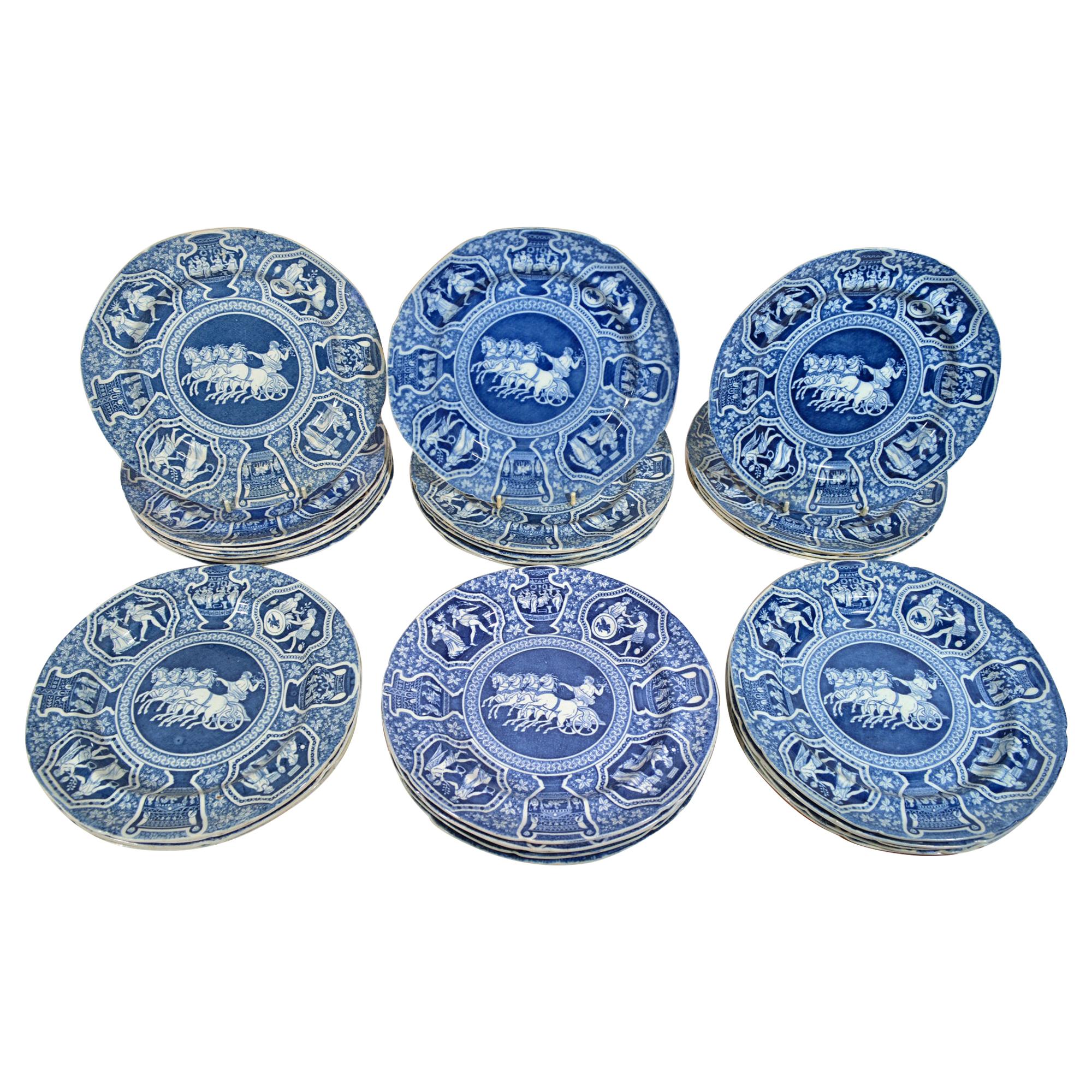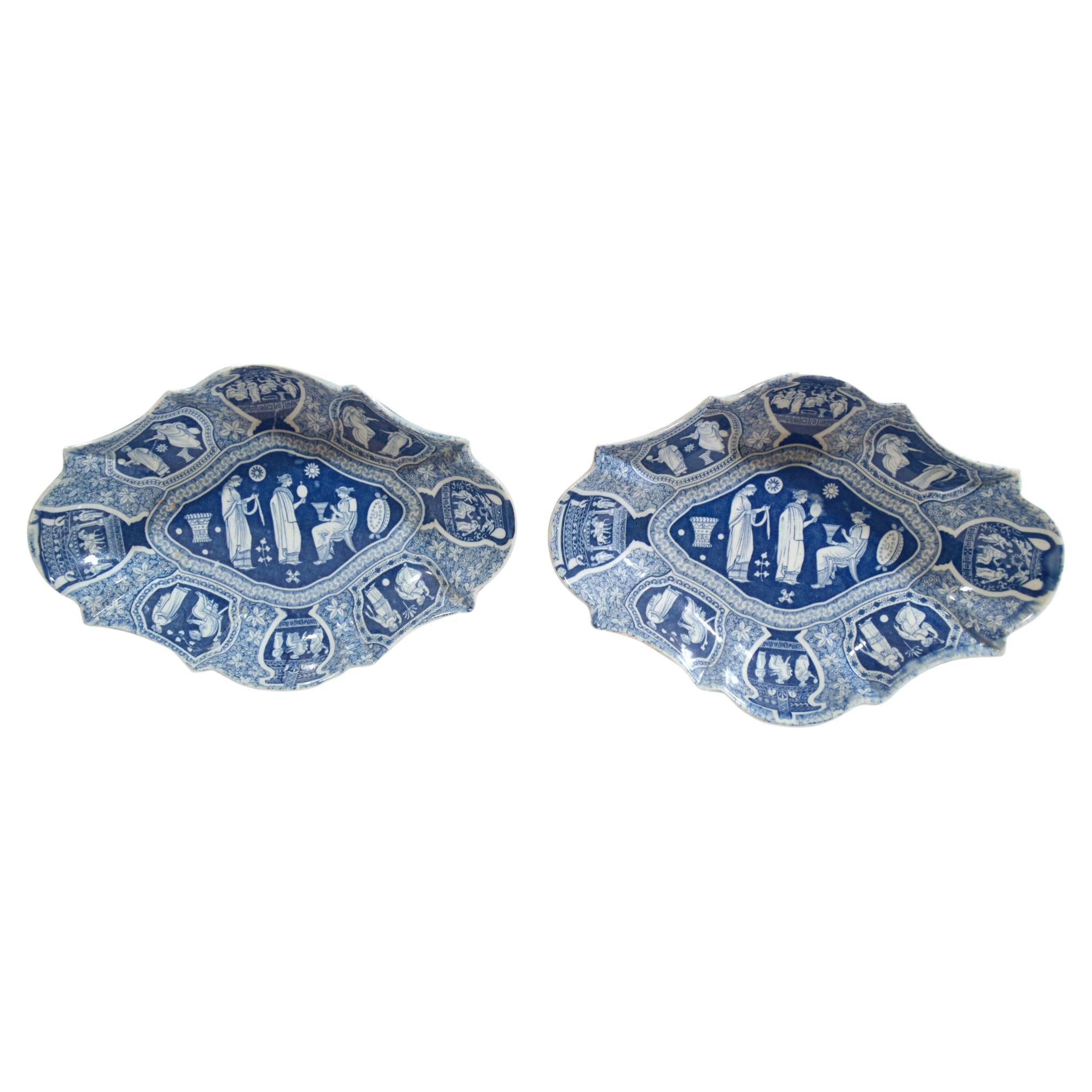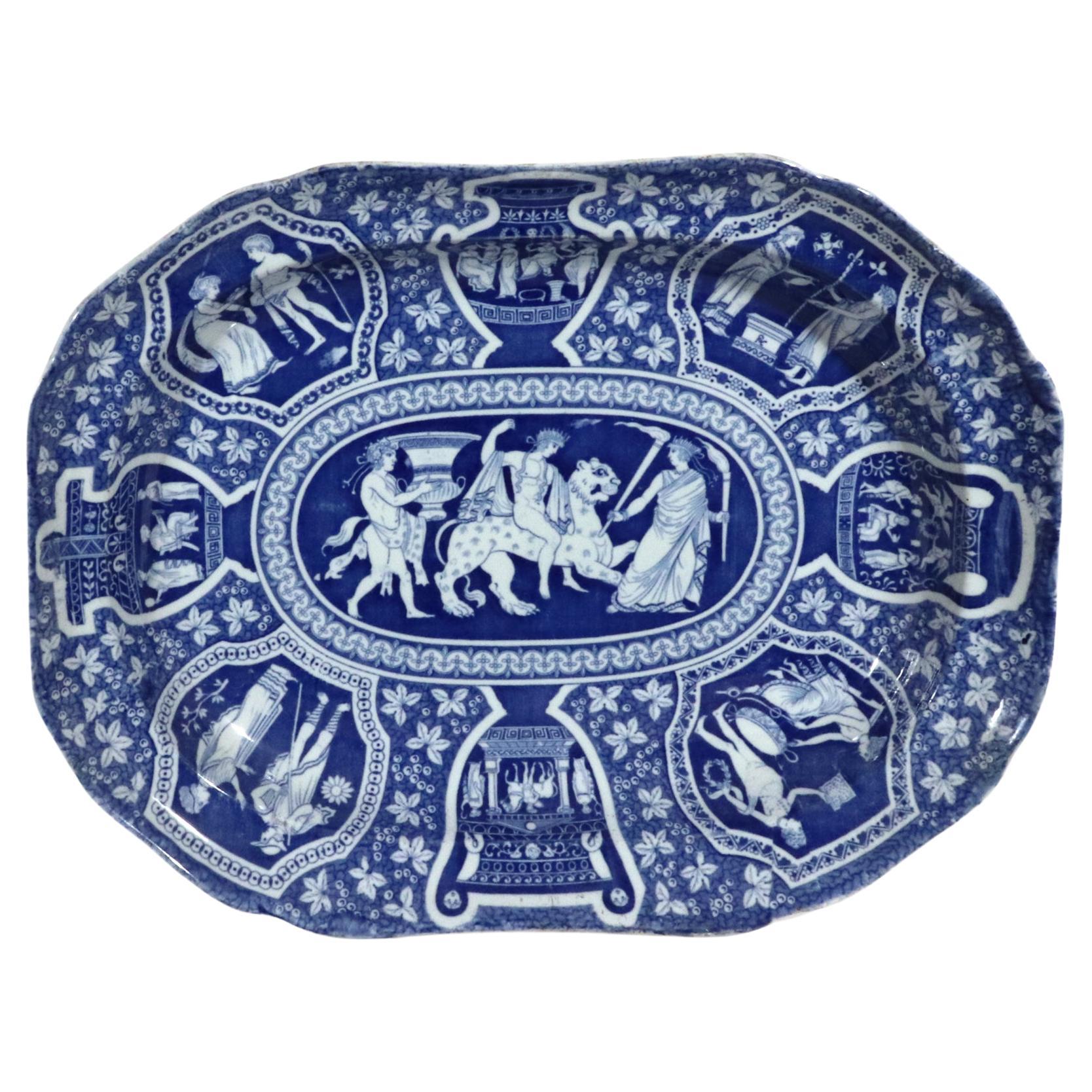Spode Neo-Classical Greek Pattern Blue Openwork Dessert Plates
About the Item
- Creator:Spode (Manufacturer)
- Dimensions:Height: 0.75 in (1.91 cm)Diameter: 7.5 in (19.05 cm)
- Sold As:Set of 4
- Style:Neoclassical (Of the Period)
- Materials and Techniques:
- Place of Origin:
- Period:
- Date of Manufacture:1810
- Condition:Wear consistent with age and use.
- Seller Location:Downingtown, PA
- Reference Number:
Spode
Spode is one of the oldest and most distinguished of the great pottery companies of Staffordshire, the time-honored home of English ceramics. The firm’s blue and white bone china transferware is a timeless classic. Spode dishes compose the sort of elegant dinner service that most of us envision on a traditional holiday table.
The company was established in 1770 in Stoke-on-Trent by Josiah Spode, a friend and neighbor of another estimable English ceramist, Josiah Wedgwood. Spode was particularly known for two technical achievements in the firm’s early decades. The first was to develop a standard formula for the making of bone china — a type of porcelain (made with a mixture of bone ash, minerals and clay) that is dazzlingly white and so strong it can be used to create very thin translucent plates and vessels. The other was to perfect the making of transferware. That process involves the transfer of pictorial images inked on tissue paper — such as the garden scenery in the famous Willow dish patterns — onto ceramics that are then sealed with a glaze. In 1833, following the sudden death of Josiah Spode III, business partner W.T. Copeland took over the company and changed its name. Collectors regard Copeland-marked pieces as Spode china. The Spode brand was revived in 1970.
From the 1820s onward, Spode enjoyed tremendous success both in Britain and elsewhere owing to the beauty and vitality of its decorative imagery. By some counts, Spode created more than 40,000 patterns in the 19th century. Many favorite Spode patterns — among them Blue Italian, India Tree, Greek and Woodland — date to the company’s early years. Spode’s most popular pattern, Christmas Tree, was introduced in 1938. Prices for Spode china vary widely, based on the size of the service, its condition and the pattern. An antique dinner service for 12 people or more, in good repair and complete with cups and serving dishes, will generally cost between $10,000 and $20,000. Such Spode services become heirlooms — a proud and timeless addition to a family’s table. And as you will see on these pages, Spode’s rich and varied wares offer a visual feast in and of themselves.
- ShippingRetrieving quote...Ships From: Downingtown, PA
- Return PolicyA return for this item may be initiated within 3 days of delivery.
- Spode Pottery Neo-Classical Greek Pattern Blue Set of Dinner Plates-33 PlatesBy SpodeLocated in Downingtown, PASpode Pottery neo-Classical Greek Pattern blue set of dinner plates-33 plates Zeus in His Chariot, Early-19th Century The Spode pottery undergla...Category
Antique Early 19th Century English Neoclassical Dinner Plates
MaterialsPearlware, Pottery
- Spode Neo-classical Greek Pattern Blue Rectangular Dessert DishesBy SpodeLocated in Downingtown, PASpode neo-Classical Greek pattern blue rectangular dessert dishes, Four figures in battle, Early 19th century The Spode Greek pattern pottery ...Category
Antique Early 18th Century English Neoclassical Pottery
MaterialsPearlware, Pottery
- Spode Neo-Classical Greek Pattern Blue Oval Dessert DishesBy SpodeLocated in Downingtown, PASpode neo-classical Greek pattern blue oval dessert dishes, "A Domestic Ceremony", Early 19th century The Spode Greek pattern pottery dishes a...Category
Antique Early 19th Century English Neoclassical Pottery
MaterialsPearlware, Pottery
- Twelve Spode Neo-Classical Greek Pattern Blue Soup PlatesBy SpodeLocated in Downingtown, PASpode Neo-classical Greek pattern blue soup plates, Refreshment for Phliasian Horseman, Set of twelve (12) Early-19th century The Spode Greek pattern ...Category
Antique Early 19th Century English Georgian Pottery
MaterialsPearlware, Pottery
- Regency Spode Pottery Neo-Classical Greek Pattern Blue DishBy SpodeLocated in Downingtown, PARegency Spode Pottery Neo-Classical Greek Pattern Blue Dish, Bellerophon's Victory Over Chimera, Early-19th century The Spode Greek pattern pottery, sh...Category
Antique Early 19th Century English Neoclassical Pottery
MaterialsPearlware, Pottery
- Spode Pottery Neo-Classical Greek Pattern Blue Deep DishBy SpodeLocated in Downingtown, PASpode pottery neo-classical Greek pattern blue deep dish, Bacchus Mounted on a Panther, Early-19th Century The Spode Greek pattern pottery shaped rectangular dish with cantered...Category
Antique Early 19th Century English Neoclassical Pottery
MaterialsPearlware, Pottery
- Early Spode Red Greek Pattern TileBy Josiah Spode, SpodeLocated in Fort Lauderdale, FLA Neoclassical red transferware tile made by Spode 1806-1810, with the ‘Refreshments for Phliasian Horseman’ pattern. Sir William Hamilton’s Collection of Etruscan, Greek and Roman antiquities, first published in 1766 by Pierre d’Hancarville, was a landmark publication in English design. It intended to disseminate the Antique style through its engravings of Attic pottery. The catalog’s faithful reproductions of Classical vases led British potteries, including Spode, to adapt or even copy the ancient art for modern life. These Spode Greek pattern tiles reflect the major influence of Hamilton’s catalog on English Neoclassicism. The central scene was taken directly from the catalog. This tile can be dated to a narrow window of production in the Spode factory, 1806-1810. During that time, Spode used a technique known as the “Pluck and Dust” method to print in red transfer designs onto creamware. Using this method, source prints were transferred overglaze using tissue imprinted with a very faint rendition of the design outlined in sticky oil. The decorator applied the tissue to the object then carefully “plucked” or pulled it away, leaving the sticky oil design behind. Then, a finely-ground enamel color was “dusted” onto the surface, sticking to any areas that had the oil. A final firing at a low temperature in the enamel kiln made the pattern permanent. The Pluck and Dust technique improved upon bat-printing and enabled larger designers to be transferred. It was short-lived, however, as under-glaze transfer printing soon took over as the preferred method for producing transferwares. Dimensions: 5 in. x 5 in. x 1/4 in. Condition: Excellent. Slight chip to the upper left corner measuring approximately 0.9 cm. in length. Provenance: The Collection of Nancy and Andrew Ramage Jonathan Horne...Category
Antique Early 19th Century English Neoclassical Pottery
MaterialsEarthenware, Creamware
- 8 Spode Aesthetic Movement Hand Painted Blue & Ivory Floral Dessert PlatesBy SpodeLocated in Great Barrington, MAThis set of 8 Spode Copelands dessert plates are perfect for a dessert course at an intimate dinner and also likely to be used as display or cabinet p...Category
Antique Early 1900s English Aesthetic Movement Porcelain
MaterialsPorcelain
- 12 Aesthetic Movement Spode Copeland Hand-Painted Dessert Plates Cobalt BlueBy SpodeLocated in Great Barrington, MAThis set of 12 lovely aesthetic movement Spode Copeland's dessert plates feature an eye-catching geometric design decorated with cobalt blue, raised gold and best of all, hand-painte...Category
Antique 1890s English Aesthetic Movement Dinner Plates
MaterialsPorcelain
- Early 19th Century Spode Red Greek Pattern TileBy Spode, Josiah SpodeLocated in Fort Lauderdale, FLA Neoclassical red transferware tile made by Spode 1806-1810, with the ‘Zeus in His Chariot’ pattern. Sir William Hamilton’s Collection of Etruscan, Greek and Roman antiquities, first published in 1766 by Pierre d’Hancarville, was a landmark publication in English design. It intended to disseminate the Antique style through its engravings of Attic pottery. The catalog’s faithful reproductions of Classical vases led British potteries, including Spode, to adapt or even copy the ancient art for modern life. These Spode Greek pattern tiles reflect the major influence of Hamilton’s catalog on English Neoclassicism. The central scene was taken directly from the catalog. This tile can be dated to a narrow window of production in the Spode factory, 1806-1810. During that time, Spode used a technique known as the “Pluck and Dust” method to print in red transfer designs onto creamware. Using this method, source prints were transferred overglaze using tissue imprinted with a very faint rendition of the design outlined in sticky oil. The decorator applied the tissue to the object then carefully “plucked” or pulled it away, leaving the sticky oil design behind. Then, a finely-ground enamel color was “dusted” onto the surface, sticking to any areas that had the oil. A final firing at a low temperature in the enamel kiln made the pattern permanent. The Pluck and Dust technique improved upon bat-printing and enabled larger designers to be transferred. It was short-lived, however, as under-glaze transfer printing soon took over as the preferred method for producing transferwares. Dimensions: 5 in. x 5 in. x 1/4 in. Condition: Excellent. Provenance: The Collection of Nancy and Andrew Ramage Jonathan Horne...Category
Antique Early 19th Century English Neoclassical Pottery
MaterialsEarthenware, Creamware
- Spode Felspar Square Dessert Plate, Gilt and Flowers, Regency 1824By SpodeLocated in London, GBThis is beautiful square dessert plate made by Spode around the year 1824. The set was made in the famous Spode Felspar china, which was a bright porcelain that included felspar rock, making it exceptionally robust and very suitable for large table services. This plate was a spare of a large dessert service that was sold previously. An identical service is on display in the Spode Museum in Stoke on Trent, on the original place where this service was produced. In a wonderful moment of serendipity, I happened to be standing and admiring that service exactly the moment the service this plate belonged to came up for auction - and I won the bid, enabling me to present it here to you! Josiah Spode was the great pioneer among the 19th Century potters in England. Around the year 1800 he perfected the bone china recipe that has been used by everyone ever since, and he was also the leading potter behind perfecting the technique of transferware, making it possible for English potters to replace the Chinese export china, which had come to an end around that time, with their own. This was fundamental to a thriving industry that would last for about 150 years and provide half the world with their tableware. In the early 19th Century Spode also made this "Felspar" porcelain, which was even stronger thanks to a large percentage of the strong felspar rock in the recipe. In the early 19th Century, dinner and dessert services were an important part of the social life of the elite, and particularly the dessert service had to be stunning in order to leave guests with a lasting impression of the wealth and power of the owner. This plate is part of such a show piece. The plate has the printed Spode Felspar Porcelain mark in puce, as well as a hand painted pattern number 3765. CONDITION REPORT The plate is in good undamaged antique condition, with its only flaw being some wear as visible in the pictures. Antique British porcelain...Category
Antique 1820s English Regency Porcelain
MaterialsPorcelain
- Set of 12 Dinner Plates and 8 Dessert Plates in Bone China by SpodeBy SpodeLocated in Kenilworth, ILSet of twelve Spode bone china dinner plates with characteristically English hand painted mixed floral bouquets in vivid polychrome enamels. The plate...Category
Antique Early 19th Century English Dinner Plates
MaterialsEnamel






